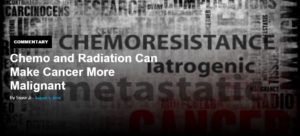
Cancer is the second leading cause of death in the developed world, and yet we are still in the dark ages when it comes to treating and understanding it.
The colossal failure of conventional cancer treatments reflects a fundamental misunderstanding of what cancer – the “enemy” – actually is. For one, chemotherapy and radiotherapy are both intrinsically carcinogenic treatments. The only justification for their use, in fact, is that they are highly effective at damaging the DNA within cells – with the hope that the cancer cells will be more susceptible to being harmed than the healthy ones (sadly, not always true).
The reality, however, is that the “collateral damage” from treatment is inevitable; it is not a matter of “if,” but to what degree the damaging side effects will occur. As in real modern warfare, the decision to strike is often based on deciding how much collateral damage to “civilian” populations is deemed acceptable. This is not unlike the fixation in toxicological risk assessments for drugs, environmental pollutants, food additives, etc., where determining “an acceptable level of harm” (a rather horrible oxymoron) to the exposed population is the first order of business.
https://australiannationalreview.com/2018/08/01/chemo-and-radiation-can-make-cancer-more-malignant/

Tom's Blog on Life and Livingness